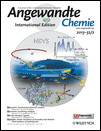Dendritic Fluoroalcohols as Catalysts for Alkene Epoxidation with Hydrogen Peroxide†
Corresponding Author
Prof. Dr. Albrecht Berkessel
Department of Chemistry, University of Cologne, Greinstrasse 4, 50939 Cologne (Germany) http://www.berkessel.de
Department of Chemistry, University of Cologne, Greinstrasse 4, 50939 Cologne (Germany) http://www.berkessel.deSearch for more papers by this authorJan Krämer
Department of Chemistry, University of Cologne, Greinstrasse 4, 50939 Cologne (Germany) http://www.berkessel.de
These authors contributed equally to this work.
Search for more papers by this authorDr. Florian Mummy
Department of Chemistry and Biochemistry, Freie Universität Berlin, Takustrasse 3, 14195 Berlin (Germany)
These authors contributed equally to this work.
Search for more papers by this authorDr. Jörg-M. Neudörfl
Department of Chemistry, University of Cologne, Greinstrasse 4, 50939 Cologne (Germany) http://www.berkessel.de
Search for more papers by this authorProf. Dr. Rainer Haag
Department of Chemistry and Biochemistry, Freie Universität Berlin, Takustrasse 3, 14195 Berlin (Germany)
Search for more papers by this authorCorresponding Author
Prof. Dr. Albrecht Berkessel
Department of Chemistry, University of Cologne, Greinstrasse 4, 50939 Cologne (Germany) http://www.berkessel.de
Department of Chemistry, University of Cologne, Greinstrasse 4, 50939 Cologne (Germany) http://www.berkessel.deSearch for more papers by this authorJan Krämer
Department of Chemistry, University of Cologne, Greinstrasse 4, 50939 Cologne (Germany) http://www.berkessel.de
These authors contributed equally to this work.
Search for more papers by this authorDr. Florian Mummy
Department of Chemistry and Biochemistry, Freie Universität Berlin, Takustrasse 3, 14195 Berlin (Germany)
These authors contributed equally to this work.
Search for more papers by this authorDr. Jörg-M. Neudörfl
Department of Chemistry, University of Cologne, Greinstrasse 4, 50939 Cologne (Germany) http://www.berkessel.de
Search for more papers by this authorProf. Dr. Rainer Haag
Department of Chemistry and Biochemistry, Freie Universität Berlin, Takustrasse 3, 14195 Berlin (Germany)
Search for more papers by this authorFinancial support by the Fonds der Chemischen Industrie is gratefully acknowledged. J.K. thanks Henkel KGaA, Düsseldorf, for a doctoral fellowship. A.B. acknowledges COST Membership (CM0905, Organocatalysis). R.H. would like to acknowledge the financial support from the Cluster of Excellence “Unifying Concepts in Catalysis”.
Graphical Abstract
Cooperativity is the key for mild catalytic epoxidation: The immobilization of fluoroalcohols on dendritic polyglycerol (by “click chemistry”) provides organocatalysts that can form multiple hydrogen bonds. The epoxidation of alkenes with aqueous hydrogen peroxide proceeds efficiently in the presence of dendritic fluoroalcohol catalysts. The supported catalysts can be separated by membrane filtration and reused.
Supporting Information
As a service to our authors and readers, this journal provides supporting information supplied by the authors. Such materials are peer reviewed and may be re-organized for online delivery, but are not copy-edited or typeset. Technical support issues arising from supporting information (other than missing files) should be addressed to the authors.
| Filename | Description |
|---|---|
| anie_201206003_sm_miscellaneous_information.pdf112.2 KB | miscellaneous_information |
Please note: The publisher is not responsible for the content or functionality of any supporting information supplied by the authors. Any queries (other than missing content) should be directed to the corresponding author for the article.
References
- 1A. Berkessel in Modern Oxidation Methods, 2nd ed. ), Wiley-VCH, Weinheim, 2010, pp. 117–145.
10.1002/9783527632039.ch4 Google Scholar
- 2J.-P. Bégué, D. Bonnet-Delpon, B. Crousse, Synlett 2004, 18–29.
- 3
- 3aA. Berkessel, J. A. Adrio, D. Hüttenhain, J.-M. Neudörfl, J. Am. Chem. Soc. 2006, 128, 8421–8426;
- 3bA. Berkessel, J. A. Adrio, J. Am. Chem. Soc. 2006, 128, 13412–13420.
- 4
- 4aA. Berkessel, M. R. M. Andreae, H. Schmickler, J. Lex, Angew. Chem. 2002, 114, 4661–4664;
10.1002/1521-3757(20021202)114:23<4661::AID-ANGE4661>3.0.CO;2-H Google ScholarAngew. Chem. Int. Ed. 2002, 41, 4481–4484;10.1002/1521-3773(20021202)41:23<4481::AID-ANIE4481>3.0.CO;2-7 CAS PubMed Web of Science® Google Scholar
- 4bA. Berkessel, M. R. M. Andreae, Tetrahedron Lett. 2001, 42, 2293–2295.
- 5
- 5aJ. Legros, B. Crousse, J. Bourdon, D. Bonnet-Delpon, J.-P. Bégué, Tetrahedron Lett. 2001, 42, 4463–4466;
- 5bJ. Legros, B. Crousse, D. Bonnet-Delpon, J.-P. Bégué, Tetrahedron 2002, 58, 3993–3998;
- 5cK. S. Ravikumar, Y. M. Zhang, J. P. Bégué, D. Bonnet-Delpon, Eur. J. Org. Chem. 1998, 2937–2940.
10.1002/(SICI)1099-0690(199812)1998:12<2937::AID-EJOC2937>3.0.CO;2-D CAS Web of Science® Google Scholar
- 6S. Roller, H. Zhou, R. Haag, Mol. Diversity 2005, 9, 305–316.
- 7
- 7aR. Haag, A. Sunder, A. Hebel, S. Roller, J. Comb. Chem. 2002, 4, 112–119;
- 7bA. Hebel, R. Haag, J. Org. Chem. 2002, 67, 9452–9455.
- 8C. Hajji, S. Roller, M. Beigi, A. Liese, R. Haag, Adv. Synth. Catal. 2006, 348, 1760–1771.
- 9
- 9aM. Beigi, R. Haag, A. Liese, Adv. Synth. Catal. 2008, 350, 919–925;
- 9bM. Beigi, S. Roller, R. Haag, A. Liese, Eur. J. Org. Chem. 2008, 2135–2141;
- 9cM. Meise, R. Haag, ChemSusChem 2008, 1, 637–642.
- 10
- 10aA. Sunder, R. Hanselmann, H. Frey, R. Mülhaupt, Macromolecules 1999, 32, 4240–4246;
- 10bA. Sunder, R. Mülhaupt, R. Haag, H. Frey, Adv. Mater. 2000, 12, 235–239.
- 11See, for example: K. M. Foote, M. John, G. Pattenden, Synlett 2001, 365–368.
- 12S. Bräse, H. Wertal, D. Vidovic, A. de Meijere, Eur. J. Org. Chem. 2005, 4167–4178.
- 13J. T. Anderson, P. L. Toogood, E. N. G. Marsh, Org. Lett. 2002, 4, 4181–4183.
- 14CCDC 892819 (4 a) and 892820 (4 b) contain the supplementary crystallographic data for this paper. These data can be obtained free of charge from The Cambridge Crystallographic Data Centre via www.ccdc.cam.ac.uk/data_request/cif.
- 15D. Hüttenhain, Dissertation, Universität zu Köln, 2007.
- 16
- 16aH. C. Kolb, M. G. Finn, K. B. Sharpless, Angew. Chem. 2001, 113, 2056;
Angew. Chem. Int. Ed. 2001, 40, 2004; for a review, see
10.1002/1521-3773(20010601)40:11<2004::AID-ANIE2004>3.0.CO;2-5 CAS PubMed Web of Science® Google ScholarC. W. Tornøe, M. Meldal, Chem. Rev. 2008, 108, 2952–3015.
- 17U. Neuenschwander, I. Hermans, J. Org. Chem. 2011, 76, 10236–10240.
- 18A. Berkessel, J. A. Adrio, Adv. Synth. Catal. 2004, 346, 275–280.
- 19K. Neimann, R. Neumann, Org. Lett. 2000, 2, 2861–2863.
- 20M. C. A. van Vliet, I. W. C. E. Arends, R. A. Sheldon, Synlett 2001, 248–250.
- 21A. Berkessel, K. Etzenbach-Effers in Hydrogen Bonding in Organic Synthesis (Ed.: ), Wiley-VCH, Weinheim, 2009, pp. 15–42.
10.1002/9783527627844.ch3 Google Scholar





